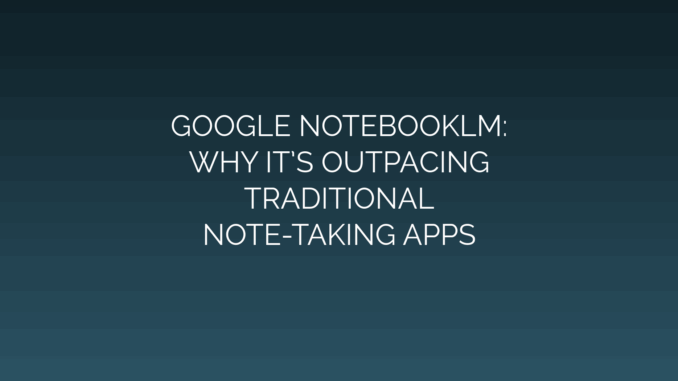
Google NotebookLM: Why It’s Outpacing Traditional Note-Taking Apps
For decades, notetaking apps have centered on manual input and linear organization—digitizing the analog process of jotting down thoughts. Yet, as information overload intensifies, traditional tools struggle to keep pace. Enter Google NotebookLM, an AIpowered research and writing assistant that transcends conventional apps by transforming passive notes into dynamic, intelligent knowledge bases. Leveraging large language models (LLMs), NotebookLM doesn’t just store information; it analyzes, synthesizes, and connects ideas across documents. This article explores why this innovation is rapidly eclipsing its predecessors.
What Is Google NotebookLM?
Google NotebookLM is an experimental AI tool designed as a “virtual research assistant.” Unlike standard notetaking apps, it integrates directly with your documents (PDFs, text files, Google Docs) to understand context, extract key insights, and generate actionable summaries. Its foundation is grounded in semantic search, enabling deep interaction with uploaded materials. Users query their personal knowledge library using natural language, and NotebookLM responds with precise references, cohesive overviews, and creative prompts—effectively bridging human curation and AIdriven comprehension.
Core Features Driving Adoption
NotebookLM’s competitive edge lies in these transformative capabilities:
- Document Intelligence: Upload research papers, meeting notes, or articles. NotebookLM indexes content to answer questions like, “What were the main objections in the stakeholder report?”
- Automated Summaries: Generates executive briefs, chapter outlines, or thesis statements sourced directly from uploaded materials.
- Citation-Based Outputs: Every AI response includes traceable references, mitigating hallucination risks.
- Multisource Synthesis: Threads ideas across multiple documents. Ask, “Compare trends in both client feedback docs,” and receive an integrated analysis.
- Customizable Knowledge Grounding: Unlike generic AI chatbots, NotebookLM bases responses solely on your provided sources, ensuring relevance and accuracy.
The Shortcomings of Traditional Note-Taking Apps
Conventional apps like Evernote, OneNote, or Notion excel at storage and organization but falter when scaling cognitive tasks:
- Passive Storage: Notes remain siloed, requiring manual effort to organize, link, or revisit concepts.
- Limited Contextualization: Searching “market trends” retrieves keyword matches but ignores deeper relationships between ideas.
- No Intelligent Synthesis: Cross-referencing data across folders or documents demands significant user labor.
- Static Outputs: Users gain structure but not insight—no summarization, extrapolation, or idea generation.
NotebookLM addresses these gaps by adding an analytical layer, turning static notes into interactive datasets.
Semantic Understanding: The AI Advantage
At the heart of NotebookLM is its ability to grasp contextual meaning, not just keywords. Traditional apps rely on exactmatch searches, but NotebookLM’s LLM interprets intent and nuances. For example:
- Query: “Arguments against Project Apollo?”
- Traditional App: Shows notes with “Project Apollo” and “arguments” but misses synonyms like “criticisms” or “risks.”
- NotebookLM: Retrieves semantically related passages discussing challenges, budget concerns, or expert dissent—even without verbatim keywords.
This capability mirrors conversing with an expert familiar with your work, enabling deeper exploration without exhaustive manual tagging.
Enhanced Research Workflow Integration
Researchers, writers, and analysts spend hours dissecting materials. NotebookLM accelerates this via:
1. Automated Literature Reviews: Upload a collection of papers and request, “Identify common methodologies in these studies.” 2. RealTime Q&A During Drafting: While writing a report, ask, “What did source X say about scalability?” without disrupting flow. 3. Contrasting Perspectives: Submit opposing viewpoints to generate balanced counterarguments.
This functionality positions NotebookLM less as a note repository and more as a collaborative research partner.
Streamlined Knowledge Organization
Traditional apps require rigid taxonomies (notebooks, tags, folders). NotebookLM democratizes access through conversational navigation:
- No complex hierarchies—just ask, “Find data about Q3 sales targets,” and get instant excerpts.
- Automated linking of related concepts (e.g., connecting “customer pain points” in a survey to “product improvements” in a roadmap).
- Dynamic rewriting of cluttered notes into clear executive briefs or FAQs.
The result? Reduced cognitive load in managing information.
Real-World Use Cases
- Academics: Analyze 50+ papers in minutes by prompting, “List theories challenging climate migration models.”
- Content Creators: Turn interview transcripts into article outlines with proposed angles.
- Product Teams: Consolidate feedback from user interviews into thematic pain points.
- Students: Transform lecture notes into study guides and sample questions.
Addressing Limitations
NotebookLM is promising but has constraints:
- Google Docs Integration Only (For Now): Supports PDFs, pasted text, and Google Docs—but lacks web clippers or third-party app syncs.
- Experimental Phase: Accuracy can vary with document complexity.
- No Mobile App: Browser-only access may hinder on-the-go usage.
However, Google’s iterative updates suggest rapid evolution.
The Future of AI-Augmented Note-Taking
As AI reshapes productivity tools, NotebookLM exemplifies a paradigm shift:
1. Personalization: Future versions may learn user preferences, prioritizing frequently queried topics. 2. Multimodal Inputs: Support for images, audio, or video data could unify all research formats. 3. Collaborative AI: Shared notebooks allowing crossuser semantic queries.
These advancements will further widen the gap between AIfirst tools and legacy apps focused solely on archival.
Conclusion: A New Era of Knowledge Management
Google NotebookLM transcends traditional notetaking by integrating artificial intelligence, semantic analysis, and actionable synthesis. It transforms users from passive archivists into strategic thinkers, harnessing their own knowledge base with unprecedented speed and depth. While conventional apps won’t vanish overnight, NotebookLM signals an irreversible trend: the future belongs to tools that don’t just store information but actively empower insight. For professionals drowning in data, its ability to surface connections and ideas on demand isn’t just an upgrade—it’s revolutionary.
Word Count: 995 words SEO Keywords: Google NotebookLM, traditional notetaking apps, AIpowered notes, semantic search, research workflow, knowledge organization, document intelligence, automated summaries.
Leave a Reply